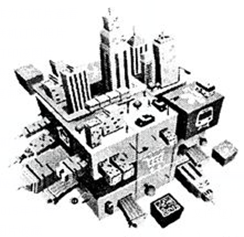
Have you noticed your life becoming a little easier? Now, when you go to a certain shopping mall, you can enjoy its free Wi-Fi there. When you want to take a taxi, you can book one with your phone. In fact, all these can be seen as the basic parts of a smart city.
The idea of a smart city was brought up by US company IBM in 2010. Generally, a smart city is a city that uses digital technologies such as the Internet to improve city planning, save money and resources, and make our life convenient. How smart can a city be? Here are great examples that we can learn from.
In 2009, Dubuque became the first smart city in the US. The city used smart water meters to take the place of traditional water meters. They can detect(探测) water waste and leakage(泄漏) and send data to let the house owner know. The same system is used for other city resources like electricity and natural gas. This way, people know how they use their resources and are glad to help reduce waste.
Santander in Spain also gives us a look at the future. If people point a phone toward a nearby bus stop, the phone immediately shows all bus lines that serve the stop as well as their arrival times. The government organized a research team and provided an App(应用程序) that collects data on almost everything: light, temperature, and the movements of cars and people. Opening the App near a supermarket provides immediate information on special offers.
1.According to the passage, which of the following is RIGHT?
A Digital technologies are used in smart cities.
B An English company first raised the idea of a smart city.
C A smart city is mainly made up of free Wi-Fi and phones.
D A smart city is still an idea and hasn’t come into being.
解析:选A。选A。细节理解题。根据第二段第二句“a smart city is a city that uses digital technologies such as the Internet…”可知,一个智能城市就是使用了数码科技。本题注意that引导的定语从句的理解,故选A。
2.The underlined word “convenient” is the closest in meaning to _____.
A useful
B normal
C suitable
D easy
解析:选D。选D。词义猜测题。根据上文的“improve city planning, save money and resources”可知,句意为:利用网络改善城市规划,节约钱和能源。根据常识,同时使我们的生活更加方便。故选D。
3.Compared to traditional water meters, smart water meters do better in _________.
A cleaning water
B supplying water
C saving water
D producing water
解析:选C。选C。细节理解题。根据第三段“They can detect water waste and leakage(泄漏)”可知,smart water meters可以探测污水和水的泄漏,也就可以节约水,故选C。
4.The example of Santander shows the use of smart systems in aspects (方面) EXCEPT _____.
A business
B health care
C traffic controlling
D public transportation
解析:选B。选B。细节理解题。根据最后一段中的一些关键词汇bus stop, movement of cars and people, supermarket, special offers可知,谈及了交通,交通控制,商业这几个方面。故选B 。
5.What’s the main idea of the passage?
A Digital technologies help improve city planning.
B Smart cities will make our future life better and smarter.
C Smart cities are very common in both Dubuque and Santander.
D Spain and the US take the leading position in building smart cities.
解析:选B。选B。主旨大意题。根据第一段,“我们在大型商场可以享受免费无限网络,可以用手机预约出租车”等信息,可知智能城市将会使我们的生活更加方便和智能化。